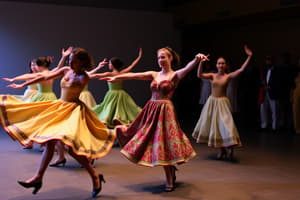Podcast
Questions and Answers
What does the German word that 'dance' originates from mean?
What does the German word that 'dance' originates from mean?
- To express
- To stretch (correct)
- To create
- To celebrate
What role did shamans play in early dance practices?
What role did shamans play in early dance practices?
- They were the primary dancers in competitions.
- They acted as physicians and religious leaders. (correct)
- They trained others in dance techniques.
- They created laws regarding dance.
Which civilization is credited with the earliest known forms of dance around 3,300 BCE?
Which civilization is credited with the earliest known forms of dance around 3,300 BCE?
- Ancient Rome
- Ancient Greece
- Ancient Cretan
- Ancient Egypt (correct)
During which period did ballet first emerge?
During which period did ballet first emerge?
Who significantly contributed to the popularity of ballet in the 1500s?
Who significantly contributed to the popularity of ballet in the 1500s?
What was one major function of dance in prehistoric cultures?
What was one major function of dance in prehistoric cultures?
Which of the following dances was NOT one of the three major dances in Ancient Egypt?
Which of the following dances was NOT one of the three major dances in Ancient Egypt?
What significant dance movement occurred during the 15th and 16th centuries in Europe?
What significant dance movement occurred during the 15th and 16th centuries in Europe?
Flashcards are hidden until you start studying
Study Notes
Dance: A Reflection of Society
- Dance emerged from the German word "damson", meaning "to stretch" or "to drunk".
- It developed as a natural expression of united feelings and actions.
- Dance acts as a mirror of society, responding to historical, religious, social, and political events.
Dance in Prehistory
- Dance was a central part of religious rituals and social expression within primitive cultures.
- It served as a method of expression and fostered tribal unity and strength.
- It was steeped in superstition and infused with magic.
- Shamans, leading dancers, functioned as healers and religious leaders, aiming to maintain the tribe's well-being and prosperity.
Ancient Egypt (3,300 BCE)
- Egyptians are considered the first people to dance.
- Archaeological evidence, including paintings of dancing figures in caves and rock shelters, supports this claim.
- Dance played a significant role in religious ceremonies and the transmission of ancient myths.
- Three main dance styles were prevalent:
- The dance of the king.
- The magical dances performed by priests.
- The dances of virgin dancers, trained for ceremonies under the guidance of priests.
Ancient Crete (300-1400 BCE)
- The Cretan civilization acted as a cultural bridge between Egyptians and Greeks in the ancient world.
- They incorporated dance into their military training, contributing to their military prowess.
Dance During the Middle Ages and Renaissance (1400 onwards)
- Ballet emerged in Italy around 1400.
- It gained significant popularity in the 1500s, primarily due to Catherine de Medici's influence after her marriage to King Henry II of France.
- Ballet dances were prominent during festivals and celebrations.
- Ballet is considered the foundational dance style for countless other dance forms.
- The "Avast Dance Movement" flourished in European courts during the 15th and 16th centuries.
- The nobility performed new court dances during this period.
- The rise of ballet as an art form became prominent in Italy and France.
- Numerous other dance forms emerged and spread throughout various countries.
Studying That Suits You
Use AI to generate personalized quizzes and flashcards to suit your learning preferences.




